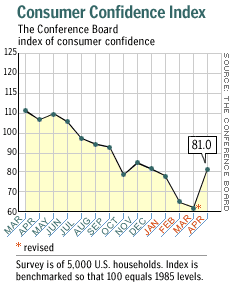NEW YORK (CNN/Money) -
Consumer confidence soared after the U.S.-led war with Iraq, posting its biggest gain since the end of the first Gulf War in 1991, a research group said Tuesday.
The Conference Board, a business research group based in New York, said its closely watched index of consumer confidence jumped to 81 in April from a revised 61.4 in March.

The jump of 19.6 points was the biggest since a 21.7-point jump between February and March 1991, at the end of the first Gulf War. Economists, on average, expected confidence to rise to just 68.7, according to a Reuters poll. The confidence numbers are important because consumer spending fuels two-thirds of the U.S. economy.
The board's index of consumer expectations about economic conditions in the next six months jumped to 84.8 from 61.4 in March, while the index of current conditions rose to 75.3 from 61.4 in March. The two components are averaged to make the headline index.
"The swift outcome in the Middle East has helped quell consumers' short-term concerns," said Lynn Franco, director of the Conference Board's Consumer Research Center. "While an increase of this magnitude occurred after the Persian Gulf War in 1991, this post-war surge differs in that both components of the index posted gains."
U.S. stock prices rose after the report but gave up most of their gains later Tuesday. Treasury bond prices edged lower.
Consumer confidence tumbled to 10-year lows in the months leading up to war with Iraq, but a post-war rebound was widely expected. Recent confidence measures from the University of Michigan and from ABC News and Money magazine had also shown a rebound.
| Related Stories
|

|
|
|
|
The Conference Board's index, the product of interviews with 5,000 households, is slower to arrive but is based on a far broader sample size than the other measures.
Of course, most analysts are quick to point out that consumer confidence doesn't always reveal much about the future course of consumer spending. Consumers felt awful in the days after the Sept. 11 terrorist attacks, for example, but continued to spend vigorously.
And the big gain in confidence at the end of the first Gulf War retreated in 1992 and 1993, as the "jobless" recovery from the 1990-91 recession dragged on. The jobless recovery from the 2001 recession, in fact, has been even longer and deeper than the last one.
Tellingly, the percentage of consumers who expected their incomes to increase in the next six months rose only slightly, to 17 from 15.8 in the prior month. This percentage has hovered at or near 10-year lows for the past several months. And the percentage of people saying jobs were "plentiful" rose to only 13.0 from 11.4 in March.
On the other hand, the percentage of consumers expecting the number of jobs available to increase rose sharply, to 16.7 from 10.8 in March.
U.S. companies have cut 2.6 million jobs since March 2001, when a recession began. Though the recession probably ended late that year, the labor market has struggled to recover.
Most economists believe that if consumers are to continue to spend enough to support the economy, the labor market will eventually rebound. Many think that businesses will be more likely to hire in the post-war period, as any uncertainty about the outcome of the war with Iraq has disappeared.
Other economists, however, think labor-market pain could continue for months, as businesses continue to try to clean up their balance sheets after the late-1990s investment bubble.

|

